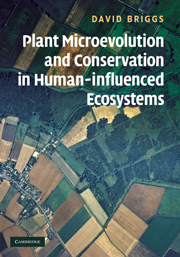Book contents
- Frontmatter
- Contents
- Preface
- Acknowledgements
- List of abbreviations
- 1 Introduction
- 2 Studying change
- 3 Key concepts in plant evolution
- 4 The origin and extent of human-influenced ecosystems
- 5 Consequences of human influences on the biosphere
- 6 Categories
- 7 Investigating microevolution in plants in anthropogenic ecosystems
- 8 Plant microevolution in managed grassland ecosystems
- 9 Harvesting crops: arable and forestry
- 10 Pollution and microevolutionary change
- 11 Introduced plants
- 12 Endangered species: investigating the extinction process at the population level
- 13 Hybridisation and speciation in anthropogenically influenced ecosystems
- 14 Ex situ conservation
- 15 In situ conservation: within and outside reserves
- 16 Creative conservation through restoration and reintroduction
- 17 Reserves in the landscape
- 18 Climate change
- 19 Microevolution and climate change
- 20 The implications of climate change for the theory and practice of conservation
- 21 Overview
- References
- Index
10 - Pollution and microevolutionary change
Published online by Cambridge University Press: 05 June 2012
- Frontmatter
- Contents
- Preface
- Acknowledgements
- List of abbreviations
- 1 Introduction
- 2 Studying change
- 3 Key concepts in plant evolution
- 4 The origin and extent of human-influenced ecosystems
- 5 Consequences of human influences on the biosphere
- 6 Categories
- 7 Investigating microevolution in plants in anthropogenic ecosystems
- 8 Plant microevolution in managed grassland ecosystems
- 9 Harvesting crops: arable and forestry
- 10 Pollution and microevolutionary change
- 11 Introduced plants
- 12 Endangered species: investigating the extinction process at the population level
- 13 Hybridisation and speciation in anthropogenically influenced ecosystems
- 14 Ex situ conservation
- 15 In situ conservation: within and outside reserves
- 16 Creative conservation through restoration and reintroduction
- 17 Reserves in the landscape
- 18 Climate change
- 19 Microevolution and climate change
- 20 The implications of climate change for the theory and practice of conservation
- 21 Overview
- References
- Index
Summary
As we have seen in earlier chapters, Darwin did not provide direct evidence for natural selection in his Origin of Species. In the post-Darwinian period, many patterns of variation in plants explicable in terms of selection were described, but the demonstration of natural selection in wild populations remained elusive. Then, in the 1950s, detailed studies of air pollution and sites contaminated with heavy metals began in earnest, providing a number of thoroughly investigated and convincing cases of natural selection in action in animals and plants (Antonovics, Bradshaw & Turner, 1971; Taylor, Pitelka & Clegg, 1991; Macnair, 1981, 1990, 1997; Shaw, 2001).
Bell and Treshow (2002) discuss the long history of concern about the effects of pollution. For example, the diarist John Evelyn published the celebrated account Fumifugium: Or the Inconvenience of the Aer and Smoake of London Dissipated in 1661. As the industrial revolution gathered pace in the nineteenth century, there was a marked deterioration in air quality in towns and cities. As urban growth accelerated and industrialisation developed in Europe and North America, trees and other vegetation were often killed or damaged, especially in towns and cities, and near smelters, factories and industrial installations. Lichens proved to be particularly sensitive indicators of the growing problem of air pollution (Bates, 2002).
- Type
- Chapter
- Information
- Publisher: Cambridge University PressPrint publication year: 2009



